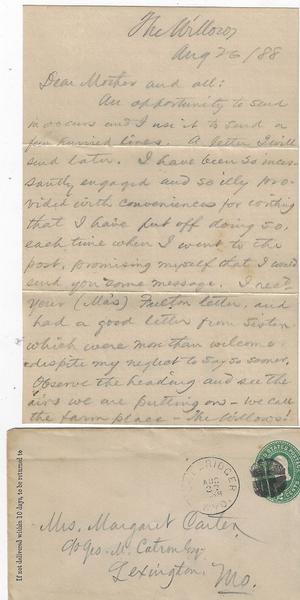THE WYOMING PALEONTOLOGICAL "BONE WARS"

(Wyoming) Carter, James Van Allen. A letter from a Wyoming pioneer, whose earlier discovery of large fossils spawned the infamous paleontological "Bone Wars", is here describing his new homestead near Fort Bridger. Written by "J" (James Van Allen Carter) and datelined "The Willows, Aug. 27, 188(8)4 pages with transmittal envelope and addressed to Mrs. Margaret Carter, his mother, who lives in Lexington, MO.
The letter in full:
The Willows
Aug. 26, 188(8)
Dear Mother and all,
An opportunity to send in occurs and I use it to send a few hurried lines. A letter I will send later. I have been so incessantly engaged and so illy provided with conveniences for writing that I have put off doing so, each time when I went to the post, promising myself that I would send you some message. I recd your (Ma's) Fulton letter, and had a good letter from Sister which were more than welcome & despite my neglect to say so sooner. Observe the heading and see the airs we are putting on - we call the farm place - The Willows!
We are able to occupy in a sort of camping way, and hope soon to get rid of the carpenter. I wont attempt this time (to) describe the place. We think it will be very pleasant. Necessity prompts the move, but I do not think we will regret it in any way. Of course it's inconvenient to have to go to Bridger to get a beefsteak or a box of matches, but when we are fairly settled supplies will be in proper and convenient proportions. The weather is rather warm just now but has been the reverse most of the time and haying was not begun until a week a go. This work is tedious and presents some worry nearly every day. My crop is apt to fall short, as is the general rule but I wont decide this question adversely until we've hauled in the last straw. My pasture feed is very fair yet, and after mowing will have fine feed left for fall pasture.
We have more or less visiting and Anne had a lunch for Willie's wife & her visiting kin the day after we pitched our pallet. Willie has located on Smith's fork at the old hard house location & is building a monster house. His wife is there and her mother is spending some weeks with her. Mr. Groshen bought the Manley place last year and they talk of living out there, but I think it is all talk. However, if they even summer there there'll be quite a string of us about 2 miles apart and it'll be quite pleasant to go visiting among the neighbors.
I wish you were all, or any of you with us. I think Ella would enjoy our home here in tho' on reflection, I believe she doesn't take to rural life. Well we'd make it nice for you Ella and perhaps convert you to its allurements. Sister Ada with her children are visiting at Bridger now. She speaks of you very often and says she would rejoice to have you visit them at Ft. Sherman. As I sit out front of the cabin and look southward, viewing the beautiful Unita mountains, I know how much Ma would enjoy the same. They have almost lost their snow - only a shot here and there on the highest peaks. I hope there'll always be a few shots as long as live under the shadow, for the snowy peaks are much of the charm. Edgar is ready to go-- so with much love from each of us to each of you I will close. I wont promise when, but as soon as I'm settled, I'll give attention to correspondence and try not to be so remiss. With much love aff'y and devotedly – J.
After the Civil War, James Van Allen Carter of Lexington, Missouri, was inspired to see the west and signed on with a freighting train in 1866 that hauled supplies to Fort Bridger, Wyoming, and settled there. In 1868, James began sending fossils he had found in Washakie Basin to the famed paleontologist, Joseph Leidy. Intrigued, Leidy visited James, Fort Bridger, and the Basin in 1872. Soon two scientific competitors , Edward Drinker Cope and Othniel Charles Marsh, appeared, and the battle was on. In 1877, railroad workers notified Marsh that they had unearthed giant fossil bones and the hunt for dinosaurs began. Leidy found a complete skeleton of what appeared to cross between an elephant and hippopotamus, which he named the Uintatherium robustum in honor of the Unita Mountains. Cope and Marsh vigorously attacked Leidy's findings, beginning an acrimonious academic debate between all three men. Leidy soon became so frustrated that he withdrew from further Western research. Wyoming, however, continued to be a hotbed of dinosaur discoveries.
Although James didn't realize it when he wrote this letter, his days at Fort Bridger were numbered as the growing network of western railroads made the overland trails obsolete. After the Army closed the post in 1890, James relocated to Evanston, Wyoming, where he established a drug store.
Source: HISTORY OF FORT BRIDGER at the Genealogy Trails website; "THE BONE WARS" from the Wyoming Tales and Trails website; Genealogical websites including ancestry.com.
Very scarce. William and James Carter Family paper collections are held by the Wyoming State Archives and Berkeley's Bancroft Library.
